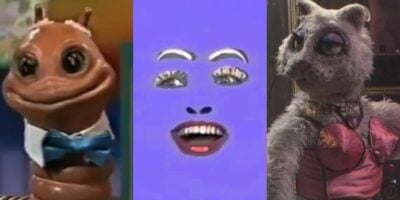Whatever else you might want to say about the 2004 film Hellbent, it certainly opens with a bang: in its very first scene, a masked (and shirtless) killer decapitates a gay couple after sneaking up on them mid-fellatio. The film is the first from director Paul Etheredge-Ouzts, and is often credited as being the original gay slasher in a genre that otherwise neglects queer characters.
However, in actuality, there are two things to say about Hellbent: firstly, it’s terrible, and secondly, it’s hardly the first horror movie to feature queer stories. The truth is, queer themes have long been present in horror. As early as Bram Stoker’s Dracula or Mary Shelley’s Frankenstein there has been a palpable, sexual tension between monsters and their victims, and these days you can’t throw a coin in a Blockbuster without it bouncing off at least seven lesbian vampire flicks.
And yet although seeing yourself reflected onscreen can be a powerful reminder of your own legitimacy, that only works if such a reflection does justice to your humanity. Whilst queerness has played a huge role in the horror tradition, it’s mostly been at the expense of queer people.
https://www.youtube.com/watch?v=nYUA20IG-Xs
More frequently than not, queer characters are set up as objects to be observed. Whether it’s the high-camp Italian-horror made famous by Dario Argento, or the aforementioned smorgasbord of lesbian vampires, the genre is rife with queer women. Films like José Ramón Larraz’s Vampyres or Ray Austin’s Virgin Witch are so heavily laden with supernatural lesbians that the horror seems almost a means to a softcore pornographic end. And similarly, if your entire knowledge of lesbians comes from films like Argento’s Tenebrae, you could be forgiven for thinking that all they do is have showers and get murdered.
Similarly, a recent industry has emerged of profoundly terrible pulp horror films centring on young men, a plethora of which have been directed by David DeCoteau. A prime example is Voodoo Academy, a film in which (as the title concisely implies) a group of hot young studs find themselves at a haunted voodoo resort. Unlike in the lesbian vampire subgenre, the gaze here is definitely queer – but in the absence of any actual plot or even sex scenes, it’s difficult to tell for whom these films are made.
Queerness has played a huge role in the horror tradition, but it’s mostly been at the expense of queer people.
Of equal concern is how horrific and violent the challenges queers in horror tend to experience. Sure, you could argue that all characters in horror have a rough go, but one of the central pillars of the genre is that everyone gets their just desserts: the stoners die because they’re stoners, the promiscuous die because of their loose morals, and in some cases, the queers die because of their cardinal sin of being queer.
Sometimes that sense of punishment can be shockingly overt, as in Sorority Party Massacre, a film in which each of the main characters has a single defining feature. For Jessie-Lynn, it’s that she’s a lesbian, and after kissing another sorority sister who turns out to be one of the killers, she gets brutally stabbed in the eye.
In recent years, this merciless torture of queer characters is often presented as commentary on the discrimination queer people face. In Hostel: Part II the implied lesbian protagonist endures gratuitous torture; in Martyrs, a queer woman is flayed by Christian extremists; and in the Westboro Baptist-inspired Red State, a pastor has a bound gay man shot in the head in front of his congregation as they pray. The monsters are clearly the people inflicting the brutality, but what good is representation if it’s only to see yourself murdered?
While the genre has historically been cruel to the LGBTQI community, the breadth and quality of our representation is improving.
Finally, and perhaps most insidiously, the horror canon has frequently treated queer people – particularly trans people – as deranged. Hitchcock’s Psycho is a classic, but from the moment Norman Bates was shown onscreen in his mother’s dress, an ugly and damaging trope was born. Silence Of The Lambs and The Texas Chainsaw Massacre both feature murderous men in dresses, while the Sleepaway Camp franchise goes a step further, by (spoilers) outing the villainous Angela as a secret transwoman, tearing away her clothes and showing her genitalia on screen.
Similarly, queer villains are almost always predatory. In 2016’s Neon Demon, lesbian make-up artist Ruby is so incapable of handling rejection that she pushes her straight crush to her death before bathing in her blood.
It’s easy to see then why people heaped praise on a terrible film like Hellbent. While it may seem like an arbitrary distinction, it’s less a film about men being murdered for being queer as much as it is a film about queers who also happen to be murdered. It’s a low bar, but it at least pulled queer stories to the very front.
And yet happily, these days a trickle of films have appeared that feature queer themes and treat queer characters with empathy and nuance. While neither are strictly horror, Darren Aronofsky’s Black Swan and Stephen Dunn’s Closet Monster both balance elements of the genre with compelling characters who are not graphically butchered nor presented as something to be ogled.
Similarly, this year, Julia Ducournau’s debut feature Raw was unsettling, stark and brilliantly queer. While the genre has historically been cruel to the LGBTQI community, the breadth and quality of our representation is improving, and as long as we continue to demand it, the only way is up.



































